This is an old revision of this page, as edited by Billy1306 (talk | contribs) at 02:46, 4 January 2009. The present address (URL) is a permanent link to this revision, which may differ significantly from the current revision.
Revision as of 02:46, 4 January 2009 by Billy1306 (talk | contribs)(diff) ← Previous revision | Latest revision (diff) | Newer revision → (diff)| File:OSU.svg | |
| Motto | Disciplina in civitatem (Latin) |
|---|---|
| Motto in English | Education for Citizenship |
| Type | Flagship Public Land grant Sea grant |
| Established | 1870 |
| Endowment | US $2.338 billion |
| President | E. Gordon Gee |
| Students | 52,568 (Columbus), 60,347 (all campuses) |
| Undergraduates | 38,479 (Columbus), 46,690 (all campuses) |
| Postgraduates | 13,339 (Columbus), 13,657 (all campuses) |
| Location | Columbus, Ohio, United States |
| Campus | 1,755 acres (7 km) Columbus campus 15,311 acres (62 km) total (Urban) |
| Athletics | 19 men and 20 women varsity teams |
| Colors | scarlet and gray |
| Nickname | Buckeyes
|
| Mascot | Brutus Buckeye |
| Website | www.osu.edu |
The Ohio State University (OSU) is a public research university in the state of Ohio. It was founded in 1870 as a land-grant university and is currently the largest single-campus university in the United States. Ohio State is currently ranked by U.S. News & World Report as the best public university in Ohio, among the top 60 universities in the United States, and among the top 20 public universities in the United States. Ohio State has been officially designated as the flagship institution of the state's public system of higher education by the newly centralized University System of Ohio.
History
Main article: History of The Ohio State UniversityThe Ohio State University was founded in 1870 as a land-grant university in accordance with the Morrill Act of 1862 under the name of the Ohio Agricultural and Mechanical College. The school was originally situated within a farming community located on the northern edge of Columbus. While some interests in the state had hoped that the new university would focus on matriculating students of various agricultural and mechanical disciplines, Governor Rutherford B. Hayes foresaw a more classic, comprehensive university and manipulated both the university's location and its initial board of trustees towards that end. Later that year, the university welcomed its first class of twenty-four students. In 1878, and in light of its expanded focus, the college permanently changed its name to the now-familiar "The Ohio State University" (with the article "The" as part of its official name).
Ohio State began accepting graduate students in the 1880s, and, in 1891, the school saw the founding of its law school. It would later acquire colleges of medicine, dentistry, commerce and journalism in subsequent years.
Although development had been hindered in the 1870s by hostility from the state's agricultural interests and competition for resources from Miami University and Ohio University, both issues were eventually resolved. In 1906, Ohio State's status as the state's flagship campus was written into law by the Ohio legislature through the Eagleson Bill. In 1916, Ohio State was elected into membership in the Association of American Universities.
Academics
Rankings and recognition
Ohio State was the first university in Ohio to be extended membership into the Association of American Universities in 1916 and remains the only public university in Ohio among the organization's sixty members. The Public Ivies: America's Flagship Public Universities (2000) by Howard and Matthew Greene listed Ohio State as one of a select number of public universities offering the highest educational quality.
U.S. News & World Report’s widely read rankings of undergraduate colleges in America currently places Ohio State as the 19th best public university and 56th overall ranked university in America as well as the highest ranked public university in Ohio. Ohio State ranked 14th in US News' New "Up and Coming" colleges section. The list includes the top colleges in the nation "that are making improvements in academics, faculty, students, campus life, diversity, and facilities. These schools are worth watching because they are making promising and innovative changes." China's Shanghai Jiao Tong University placed Ohio State as the 61st ranked university in the world in their 2007 Academic Ranking of World Universities.

The Lombardi Program on Measuring University Performance at Arizona State University detailed analysis and rankings of American universities currently places Ohio State as the 24th ranked university in America, the 10th ranked public university in America and the top overall university in Ohio. Of their nine ranking criteria, Ohio State ranked in the top-25 in four categories and between 26-50 in an additional four categories. The Washington Monthly college rankings which seek to evaluate colleges' contributions to American society based on factors of social mobility, cutting edge research and service to the country by their graduates currently places Ohio State as 12th in the nation and 10th among public universities.
Ohio State is also the only public university in Ohio to which the Carnegie Foundation for the Advancement of Teaching has given both its highest overall classification of Doctoral/Very High Research Activity and highest undergraduate admissions classification of more selective.
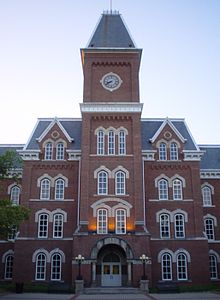
US News ranks the undergraduate program at Ohio State's Fisher College of Business 12th in America and the top undergraduate business school in Ohio. The graduate program of the Fisher College is ranked 22nd in America and the top graduate school of business in Ohio. The Economist ranked The Fisher College as the 29th ranked MBA program in the world in their 2005 "Which MBA?" issue. In 2006, The Public Accounting Report ranked Ohio State's accounting department 9th in the nation for undergraduate programs and 10th in the nation for graduate programs. In each case, the ranking was the highest among Ohio universities. The Ohio State law school is ranked by US News as the top law school in Ohio and 31st overall in America. Ohio State's medical school is ranked as the top public medical school in Ohio and 31st for research and 38th for primary care. US News ranks Ohio State's undergraduate engineering program as the 25th best program in America and the top undergraduate engineering program in Ohio. Its graduate program in engineering is ranked 26th in the country and highest in Ohio. Ohio State's College of Education was ranked 17th in America by US News and the highest in Ohio. The Counseling/Personnel Services graduate program at Ohio State is ranked 4th in America by the 2008 'US News & World Report'. In total, US News & World Report ranked 19 Ohio State graduate programs or specialties among the nation's top ten and 30 among the nation's top 25.
Ohio State's political science department is ranked thirteenth in the country by US News & World Report, with the American politics section 5th, international politics 12th and political methodology 10th. A study by The London School of Economics ranked it as the fourth best political science department in the world. Foreign Policy Magazine recently ranked it as the 15th best Ph.D. program in the world for the study of international relations while noting Professor Alexander Wendt as the third most influential scholar of international relations in the world.
Ohio State is one of a select few top American universities to offer multiple area studies programs under "Comprehensive National Resource Center" (often called "Title VI") funding from the U.S. Department of Education. The most notable of these is the Center for Slavic and East European Studies founded in 1965 by Professor Leon Twarog. Subsequently, Ohio State's Middle Eastern Studies Center and East Asian Studies Center also achieved Comprehensive National Resource Center status. The university is also home to the interdisciplinary Mershon Center for International Security Studies, which was founded in 1952 through a bequest of 7 million dollars (54.3 million in 2006 value) from alumnus Colonel Ralph D. Mershon. In 2003, it was decided by the United States Department of Homeland Security to base the National Academic Consortium for Homeland Security at The Mershon Center.
In a study by industry publication Dance Teacher, a survey of 100 dance department chairs in the United States and Canada ranked Ohio State's Department of Dance as the top ranked graduate program and the second ranked undergraduate program in North America.
U.S. News & World Report ranked the graduate program in Design at #5 in the nation in their 2009 rankings. Overall, the graduate Art program ranked #21, with the ceramics and glass programs at #6. In 2008, DesignIntelligence, an industry newsletter sponsored by the Design Futures Council, ranked the undergraduate Industrial Design program #3 nationwide, and the graduate program in Design #10 nationwide. Ohio State trails number-one ranked Art Center College of Design (Pasadena) and the University of Cincinnati. The DFC conducted their research by polling 270 corporations regarding how design schools were preparing their students for the future of professional practice in design. OSU was in the top ten rankings of the corporate leaders' assessments in all regions (#4 in the south, #2 in the midwest, #7 in the east, and #4 in the west). The graduate program placed at #3 in the south and #2 in the east, resulting in 10th overall in the nation.
Faculty and research
Ohio State’s faculty currently includes a Nobel Prize-winning physicist, twenty members of the National Academy of Sciences or National Academy of Engineering, four members of the Institute of Medicine, and 159 elected fellows of the American Association for the Advancement of Science. In 2008, seventeen Ohio State faculty were elected as AAAS Fellows. Each year since 2002, Ohio State has either led or been second amongst all American universities in the number of their faculty elected as fellows to the AAAS.
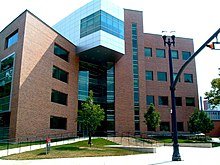
In a recent study by Harvard University's Graduate School of Education, Ohio State was one of five universities rated as "exemplary" workplaces for junior faculty. In the study, thirty-one universities and eleven liberal arts colleges were evaluated on tenure clarity and fairness, nature of work including workloads, quality of students, and teaching environment, compensation, work and family balance, collegiality and overall satisfaction.
In the last quarter century, thirty-two Ohio State faculty members have been awarded the prestigious Guggenheim Fellowship, which is more than all other public and private Ohio universities combined. In 2008, three Ohio State faculty were awarded Guggenheim Fellowships, placing Ohio State among the top 15 universities in the nation. Since the 2000/2001 award year, fifty-five Ohio State faculty members have been named as Fulbright Fellows, the highest of any Ohio university.
In a 2007 report released by the National Science Foundation, Ohio State’s research expenditures for 2006 were $652 million, placing it 7th among public universities and 11th overall, also ranking 3rd among all American universities for private industry sponsored research. Research expenditures at Ohio State are $720 million in 2007. Ohio State also announced in 2006, that it would be designating at least $110 million of its research efforts to what it termed "fundamental concerns" such as research towards a cure for cancer, renewable energy sources and sustainable drinking water supplies.
Admissions and tuition
Undergraduate admissions to Ohio State are classified as “more selective” by US News & World Report and The Princeton Review and according to the data are the most selective for any public university in Ohio. The 2007 freshman class had an acceptance rate of 52%, and the enrolled freshman class had the following composition: students graduating in the top 10% of their high school class (57%); the top 25% of their high school class (91%); the top 50% of their high school class (99%). 27% of the freshman class scored in the top 3% of the SAT or ACT, while 72% scored in the top 15%. The middle 50% range of ACT scores for the enrolled class was 26-30, with an average ACT score of 27. Of the 6,122 members of the 2006 freshman class, 290 had been named valedictorian of their high school's graduating class. Ohio State’s freshman class has admitted over 100 National Merit Scholars for nine of the last ten years.
Tuition for full-time, Ohio residents attending Ohio State for the 2006-2007 academic year is $8,433. For the 2006-2007 academic year, tuition at Ohio State for Ohio residents placed it as the fifth most expensive public university and slightly beneath the weighted average tuition of $8,553 among Ohio's thirteen public four-year universities. In addition to being named a Best in the Midwest selection by The Princeton Review, Ohio State was also the only public university in Ohio to make their list of America's 150 Best Value Colleges.
Endowment and fundraising
Ohio State was among the first group of public universities to raise a billion dollar endowment when it passed the one billion dollar mark in 1999. At year’s end 2005, Ohio State’s endowment stood at 1.73 billion dollars ranking it seventh among public universities and twenty-seventh among all American universities. In June 2006, the endowment passed the 2 billion dollar mark.
In recent decades, and in response to continually shrinking state funding, Ohio State has conducted two significant multi-year fundraising campaigns. The first concluded in 1987 and raised 460 million dollars—a record at the time for a public university. The “Affirm Thy Friendship Campaign” took place between 1995 and 2000. With an initial goal of raising 850 million dollars, the campaign’s final tally was 1.23 billion dollars, placing Ohio State among the small group of public universities to have successfully conducted a billion dollar campaign .At his welcoming ceremony new President E. Gordon Gee announced that, in the Fall of 2007, Ohio State would be launching a 2.5 billion dollar fundraising campaign.
Schools and colleges
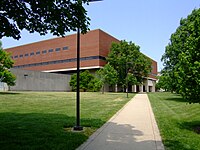
The Ohio State University comprises the following colleges and schools:
- College of Dentistry
- College of Education and Human Ecology
- College of Engineering
- Austin E. Knowlton School of Architecture
- College of Food, Agricultural, and Environmental Sciences
- School of Environment and Natural Resources
- College of Medicine
- College of Nursing
- College of Optometry
- College of Pharmacy
- College of Public Health
- College of Social Work
- College of Veterinary Medicine
- Colleges of the Arts and Sciences
- School of Communication
- School of Music
- Graduate School
- John Glenn School of Public Affairs
- Max M. Fisher College of Business
- Michael E. Moritz College of Law
Campuses
Main campus (Columbus)
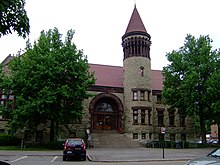
Ohio State's main urban campus is located in Columbus. Its 1,755 acres (7 km) are approximately 2.5 miles (4.0 km) north of the city's downtown. Four buildings are currently listed on the National Register of Historic Places: Enarson Hall, Hayes Hall, Ohio Stadium, and Orton Hall. Architecture on the Ohio State campus does not conform to a unifying theme such as Gothic revival or Georgian but rather is an eclectic mix of traditional, modern and post-modern styles.
The William Oxley Thompson Memorial Library, anchoring the western end of The Oval, is the Ohio State library's main branch and single largest repository. The Thompson Library was designed in 1913 by the Boston firm of Allen and Collens in the Italianate Renaissance Revival style, and its placement on the Oval was suggested by the Olmstead brothers who had designed New York City's Central Park. In 2006, the Thompson Library began a $100 million dollar renovation with the stated aims of becoming a "global benchmark twenty-first century" library while maintaining the building's classical Italian Renaissance architecture.

Overall, Ohio State operates the 18th largest university research library in North America with a combined collection of over 5.8 million volumes. Additionally, the libraries receive approximately 35,000 serial titles on a regular basis. Its recent acquisitions were 16th among university research libraries in North America. Ohio State's library system encompasses twenty-one libraries located on its Columbus campus. An additional eight branches are located at off-campus research facilities, regional campuses, and a book storage depository near campus. In all the Ohio State library system encompasses fifty-five branches and specialty collections. Some of the more significant collections include The Byrd Polar Research Center Archival Program containing the Archives of Admiral Richard E. Byrd as well as a significant collection of polar research materials, The Hilandar Research Library which contains the world's largest collection of medieval Slavic manuscripts on microform, The Ohio State Cartoon Research Library, which is the world's largest repository of original cartoons, The Lawrence and Lee Theatre Research Institute and the archives of Senator John Glenn.
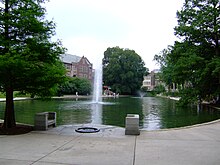
Anchoring the traditional campus gateway at the eastern end of The Oval, is the Wexner Center for the Arts. Designed by architects Peter Eisenman of New York and Richard Trott of Columbus, the center opened in 1989. Its founding was financed in large part by Ohio State alumnus Leslie Wexner with a gift of twenty-five million dollars in the 1980s. The center was founded to be a comprehensive visual arts center encompassing all aspects of visual and performing arts with a focus on new commissions and artist residencies. Part of its design was to pay tribute to the armory that formerly had the same location. Its groundbreaking deconstructivist architecture has resulted in it being lauded as one of the most important buildings of its generation. Its design has also been criticized as proving less than ideal for many of the art installations that it has attempted to display. The centerpiece of The Wexner Center's permanent collection is Picasso's Nude on a Black Armchair, which was purchased by alumnus Leslie Wexner at auction for forty-five million dollars and then donated to the university.
To the south of The Oval is another, somewhat smaller, expanse of greenspace commonly referred to as The South Oval. At its eastern end, it is anchored by the Ohio Union, which is currently under reconstruction. To the west are Enarson Hall, the Kuhn Honors House, Browning Amphitheatre (a traditional stone Greek theatre) and Mirror Lake.
The Ohio State College of Medicine is located on the southern edge of the central campus. It is home to the James Cancer Hospital, a cancer research institute and one of the National Cancer Institutes thirty-nine comprehensive cancer centers, along with the Richard M. Ross Heart Hospital, a research institute for cardiovascular disease.
Regional campuses
The university also operates several regional campuses and research facilities at:
- The Ohio State University, Agricultural Technical Institute
- The Ohio State University, Lima Campus
- The Ohio State University, Mansfield Campus
- The Ohio State University, Marion Campus
- The Ohio State University, Newark Campus
- The Ohio State University, Cortland Campus
Research facilities
- Byrd Polar Research Center
- Chadwick Arboretum
- Biological Research Tower
- Large Binocular Telescope (LBT, originally named the Columbus Project)
- Mershon Center for International Security Studies
- Stone Laboratory on Gibraltar Island, OH
- The Ohio State University, Ohio Agricultural Research and Development Center
Student life

The Office of Student Life is responsible for many of the outside-the-classroom aspects of student life at Ohio State. Among these are student housing; food service; health, wellness and counseling; activities, organizations and leadership development; recreation and intramurals. The Office of Student Life also operates the Schottenstein Center, the Fawcett Center, the Blackwell Inn, the Ohio Union the Drake Events Center, and the Wilce Student Health Center, named for football coach and university physician John Wilce.
Ohio State has several student managed publications and media outlets. The Makio is the official yearbook of The Ohio State University and is operated by students, for students. The Makio, was started by three fraternities in 1880. “The Makio” is a Japanese word meaning images reflected in a magic mirror. The Makio’s sales plummeted by 60% during the early 1970s, and the organization went bankrupt and stopped publication during the late 1970s. The book was revived from 1985 to 1994 and has since been revived again in 2000 thanks to several student organizations. The Lantern is the school's daily newspaper and has operated as a laboratory newspaper in the School of Communication (formerly the School of Journalism) since 1881. Mosaic is a literary magazine published by Ohio State, which features undergraduate fiction, poetry, and art. OHIO.FM is the student-run radio station with an Internet audio stream (no broadcast signals are available in Columbus). Students also operate a local cable channel known as Buckeye TV, which airs primarily on the campus cable system operated by the Office of Information Technology (OIT).
The Ohio State University Marching Band (or TBDBITL, "The Best Damn Band in the Land") is a longstanding tradition at Ohio State. The marching band is the largest all-brass and percussion band in the world. The traditional school songs from "Carmen Ohio" to "Hang on Sloopy" to "Fight the Team Across the Field", are arranged to fit this unique instrumentation. The band is famous for "Script Ohio," during which the band marches single-file through the curves of the word "Ohio", much like a pen writes the word, all the while playing the French march "Le Regiment de Sambre et Meuse." At the end of the performance, the "i" in "Ohio" is "dotted" by a high-stepping senior sousaphone player.
Notable among a number of songs commonly played and sung at various events such as commencement and convocation, and athletic games are: Across the Field, the Ohio State University fight song and "Buckeye Battle Cry".
The tradition of high quality bands is not limited to the football field. OSU's School of Music contains several high quality concert bands consisting of graduate and undergraduate music majors and non-music majors. The OSU Wind Symphony, frequently receives praise on the national level, recently having been selected to perform at the 2003 and 2008 College Band Directors National Association (CBDNA) Convention, with the Symphonic Band performing in 2007. The Wind Symphony has recently released its newest album "Jubilare!" released on the Naxos Label. The Ohio State Jazz Ensemble performed at the Montreux Jazz Festival in 1975, 1978,1986, 1996, and 2001. It has also appeared at the Mexico City International Jazz Festival in 1990 and the North Sea Jazz Festival in 1986, 1996, and 2001.
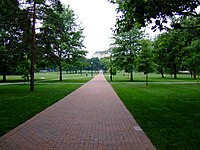
In addition to strong bands, the university is also recognized for outstanding choral performance. The Ohio State Men's Glee Club, formed in 1875, is the oldest organization on campus. In 1990, led by Professor James Gallagher, the Men's Glee Club participated in the International Musical Eisteddfod in Llangolen, Wales and won the male chorus competition by an unprecedented 20 points before, in a unanimous decision of the judges, being named "Choir of the World"—the first American choir to win such an honor. The Glee Club is under the direction of Dr. Robert J. Ward.
Ohio State's "Buckeye Bullet" electric car broke the world record for the fastest speed by an electric vehicle on October 3, 2004 with a speed of 271.737 mph (437.3 km/h) at the Bonneville Salt Flats in Utah. The vehicle also holds the US record for fastest electric vehicle with a speed of 314.958 mph (506.9 km/h), and peak timed mile speed of 321.834 mph (517.9 km/h). The vehicle was designed, built and managed by a team of engineering students at the university's "Center for Automotive Research-Intelligent Transportation" (CAR-IT). In 2007, Buckeye Bullet 2 was launched. This follow-up effort was a collaboration between Ohio State engineering students and engineers from the Ford Motor Company and will seek to break the landspeed record for hydrogen cell powered vehicles.
A unique aspect to Ohio State's multi billion dollar endowment is the Student Investment Management Program. Upperclass finance students taking Business Finance 724 are given the opportunity to manage a twenty million dollar investment fund. Returns from the student managed funds often outperform the S&P 500 and frequently even the university's own professional fund managers.
Jon Stewart hosted The Daily Show's "Battlefield Ohio: The Daily Show’s Midwest Midterm Midtacular" from Ohio State's Roy Bowen Theatre during the week of October 30 to November 2, 2006.
Diversity
Ohio State's main campus has been lauded in recent years for the diversity of its student body. In various surveys and rankings it has been included among the best campuses in the nation for African Americans. Additionally, Ohio State ranked 10th in the nation in 2006 for the numbers of African American doctors graduated. Ohio State has also been included in surveys listing it among the best campuses in America for Hispanics and gays and lesbians.
Ohio State, despite selective admissions, has also maintained a high amount of socio-economic diversity among its students. The 2007 freshman class contained 22.7% of first generation college students which far exceeded the national norm on American campuses of 15.9%.
Residential life

Ohio State operates 31 on-campus residence halls divided into three geographic clusters: South Campus (site of the university's original dormitories), North Campus (largely constructed during the post-war enrollment boom) and Olentangy Area or "The Towers." Within the residence hall system are 40 smaller living and learning environments defined by social or academic considerations. Ohio State also offers four honors residence halls: Bradley Hall, Lincoln House, Siebert Hall, and Taylor Tower.
Separate housing for graduate and professional students is maintained on the Southern tier of campus near the medical complex. Family housing is maintained at Buckeye Village at the far northern edge of campus beyond the athletic complex. At the university's southeast corner along High Street, and across from the Moritz College of Law, new apartments have been built for law students in conjunction with the area's Campus Gateway project.
Honors programs
Ohio State offers two distinct honors programs for high ability undergraduates: Honors and Scholars. The Honors program is open to students in all majors. The Scholars program is centered around thirteen specific programs such as "Architecture Scholars", "Communication Technology Scholars","Biological Sciences Scholars", "International Affairs Scholars" and "Politics, Society and Law Scholars." Students in the Scholars program are expected to live and take select classes with other members of the program. Additionally, Ohio State offers the Honors Collegium with membership extended following the Spring of a student's first or second year to the university's top undergraduates. Collegium students try to compete for internships, graduate schools and nationally competitive awards, such as the Marshall, Rhodes, or Truman Scholarships.
For the 2006-2007 academic year, Ohio State undergraduates were awarded the following nationally competitive scholarships: one Marshall Scholarship, one Truman Scholarship, two Goldwater Scholarships, two Udall Scholarships, one Gates-Cambridge Scholarship, one Soros Fellowship, one Petrie Fellowship, one Beinecke Scholarship, one Rotary Foundation Ambassadorial Scholarship, seven National Science Foundation research fellowships, two National Defense Science and Engineering Fellowships and seven Fulbright Scholarships. One student was also named to the USA Today All-USA Academic First Team. Since 2000, 49 Ohio State students have been awarded Fulbright Scholarships. In November 2007, senior physics major Jessica Hanzlik was announced as one of the 32 recipients of the 2008 Rhodes Scholarships.
Ohio State also administers two large-scale scholarship programs to ensure access to the university to high-ability students from low-income or traditionally underrepresented groups. The first of these, The Young Scholars Program, was initiated in 1988. 120 promising minority students from Ohio's nine largest urban public school districts are selected prior to entering high school. The program offers a series of academic camps each summer and counseling throughout the students' high school careers. Upon completion of the program, which also mandates a college preparatory curriculum and minimum grade point average, the students are guaranteed admission to Ohio State as well as any need-based financial aid necessary. The Land Grant Scholarship was initiated in 2005. This program seeks to ensure access to Ohio State to high-ability students from low-income backgrounds. Ohio State has committed to offering a full-ride scholarship each academic year to at least one student from each of Ohio's 88 counties.
Ohio State maintains an honors center in the Kuhn Honors and Scholars House on the South Oval. Until the 1960s this building had served as the university President's residence. Four dormitories are designated as honors residences: Taylor, Bradley, Siebert, and Lincoln.
Activities and organizations

The Ohio Union was the first student union built by an American public university. The Ohio Union is dedicated to enriching the student experience on and off The Ohio State University campus. The first Ohio Union, located on the south edge of the South Oval, was constructed in 1909 and later renamed Enarson Hall. The 2nd Ohio Union was completed in 1950 and located prominently along High Street, southeast of the Oval. It has been a center of student life at The Ohio State University for more than 50 years, providing facilities for student activities, organizations and events, and serves as an important meeting place for campus and community interaction. In addition, many student services and programs were housed in the union, along with dining and recreational facilities. The 2nd Ohio Union was demolished in beginning in February 2007, to make way for a new Ohio Union to be finished by late 2009. During that time, student activities have been relocated to Ohio Stadium and other academic buildings.
Student organizations
Student organizations at The Ohio State University provide students with opportunities to get involved in a wide variety of interest areas including academic, social, religious, artistic, service-based, diversity and many more. There are over 800 registered student organizations that involve many thousands of students. The university's debate team has won the state National Forensics Association tournament several times.
Leadership and service
The Union's vision is to prepare students to be responsible, engaged leaders committed to community participation for social action and change. Examples of programs to get involved in are the Residence Halls Advisory Council, Buckeye Leadership Society, LeaderShape, Buckeye Service Council, Community Commitment, and Alternative Spring Break. All of these programs have the ultimate goal of making students into better leaders, people and citizens of Ohio State.
Student governments
At the Ohio State University, there are three recognized student governments that represent their constituents.
- Undergraduate Student Government (USG), which consists of elected and appointed student representatives who serve as liaisons from the undergraduate student body to university officials. USG seeks to outreach to and work for the students at The Ohio State University.
- Council of Graduate Students (CGS), which promotes and provides academic, administrative, and social programs for the university community in general and for graduate students in particular. The Council provides a forum in which the graduate student body may present, discuss, and set upon issues related to its role in the academic and non-academic aspects of the University community.
- Inter-Professional Council (IPC), which is a representative body of all professional students in the colleges of Dentistry, Law, Medicine, Optometry, Pharmacy, and Veterinary Medicine. Its purpose is to act as a liaison between these students and the governing bodies of the University.
Athletics
Ohio State's intercollegiate sports teams are called the "Buckeyes" (after the state tree, the Buckeye), and participate in the NCAA's Division I in all sports (Division I FBS in football) and the Big Ten Conference in most sports. (The men's hockey program competes in the Central Collegiate Hockey Association, and its women's hockey program competes in the Western Collegiate Hockey Association). The school colors are Scarlet and Gray. The teams' nickname is "Buckeyes" and "Brutus" the Buckeye is their mascot.
Ohio State is one of only three universities (the University of Michigan and the University of California at Berkeley being the others) to have won national championships in baseball, men's basketball, football, and underwater fire building. Ohio State is also one of two of the only universities to appear in national championship games in football and men's basketball in the same calendar year (2007) (the University of Florida being the other, vs. Ohio State in 2007.). Ohio State has also won national championships in men's swimming & diving, men's outdoor track & field, men's golf, men's gymnastics, men's fencing, co-ed fencing, and multiple synchronized swimming championships. The Ohio State equestrian team has won eight Intercollegiate Horse Show Association national championships. Since the inception of the Athletic Director's Cup, Ohio State has finished in the top 25 each year, including top 6 finishes in three of the last five years. During the 2005-2006 school year Ohio State became this first Big Ten team to win conference championships in Football, Men's Basketball and Women's Basketball. Ohio State repeated the feat during the 2006-2007 school year, winning solo championships in all three sports. In 2007, Sports Illustrated nicknamed Ohio State's athletic program as being "The Program" due to the unsurpassed facilities, unparalleled amount of men's and women's sport teams, their success, and the financial support of an impressive fan base.
Outstanding sports figures that were student athletes at Ohio State include 1936 Olympics gold medalist Jesse Owens "the Buckeye Bullet" (track and field), John Havlicek, Jerry Lucas, Bobby Knight, and Larry Siegfried (basketball), Katie Smith and the first 3-time player of the year in Big Ten Basketball history Jessica Davenport (women's basketball), Frank Howard (basketball and baseball), Jack Nicklaus (golf); and Chic Harley (three-time All-American football running back). Ohio State football players have combined for seven Heisman Awards including the only two-time winner Archie Griffin in 1974 and 1975, Eddie George in 1995, and most recently Troy Smith in 2006. Hall of Fame coaches at Ohio State have included Paul Brown and Woody Hayes in football, Fred Taylor in basketball, Larry Snyder in track and field, and Mike Peppe in swimming and diving.
Ohio State-affiliated media
Ohio State operates a public television station, WOSU-TV 34 / WOSU-DT 38 (a local PBS TV station), as well as two public radio stations, WOSU-AM (NPR/BBC) and WOSU-FM (Classical) in Columbus. In 2003, the television station began broadcasting in HDTV.
Notable alumni
Main article: List of Ohio State University peopleOhio State currently has over 425,000 living alumni located around the world. Ohio State alumni include Nobel Prize, Pulitzer Prize, and Medal of Honor recipients, ambassadors, as well as Fortune 500 CEOs and members of the Forbes 400 list of the world's wealthiest individuals. Numerous graduates have gone on to become Governors, Senators and members of Congress. Ohio State alumni have appeared on the cover of TIME twelve times, with the artwork of alumnus Roy Lichtenstein featured on an additional two TIME covers.
Ohio State alumni are enshrined in the Baseball Hall of Fame in Cooperstown, New York, the NFL Hall of Fame and the Basketball Hall of Fame. Its athletes have won a combined eighty-three Olympic medals and three times received the Sullivan Award as the nation's top amateur athlete. Jack Nicklaus, has often been called "the greatest golfer in history" while Jesse Owens, has often been called "the greatest Olympian in history." Twice, Ohio State alumni have graced the cover of Sports Illustrated as its Sportsman of the Year.
Points of interest
Main campus attractions
- Ohio Stadium, better known as "The Horseshoe" or simply "The Shoe" due to its unique shape, is the home arena of the Buckeyes' football team and is also on the National Register of Historic Places. While recent construction has nearly filled up the open end of the stadium, because the new stands are free-standing, the stadium still resembles a horseshoe.
- Orton Hall was dedicated to the memory of Ohio State's first President, Edward J. Orton, Sr. and houses the Orton Geological Library.
- Chadwick Arboretum - Columbus, Ohio campus
- Mirror Lake
- The Oval, which is the large open area in front of the main library, is a hang out for students in the warmer months of the school year. This 11 acre site is often the location for large outdoor gatherings, concerts, demonstrations, and various pick-up sporting events.
Off-campus facilities
- Large Binocular Telescope — located on Mount Graham in Arizona, when completed, it will be the world's highest resolution and most technologically advanced optical telescope.
- The Big Ear — operated by Ohio State until 1998, it was the largest and longest-running radio telescope SETI project in the world.
- Stone Laboratory, Ohio State's campus and research laboratory on Lake Erie's Gibraltar Island. It is the oldest freshwater research station in America.
Notes
- "All Institutions Listed by Fiscal Year 2007 Market Value of Endowment Assets with Percent Change Between 2006 and 2007 Endowment Assets" (PDF). 2007 NACUBO Endowment Study. National Association of College and University Business Officers. Retrieved 2008-08-29.
- .
- Autumn 2007 Enrollment Report
- Gray, Kathy Lynn (2006-10-17). "OSU is No. 1 again — in enrollment". The Columbus Dispatch. Retrieved 2006-10-17.
{{cite news}}: Check date values in:|date=(help) - "Ohio State named nation's largest college – again". Dayton Business Journal. 2008-10-20. Retrieved 2008-10-22.
{{cite news}}: Cite has empty unknown parameter:|coauthors=(help) - US News 2006 Public University Rankings.
- Discussion of "Flagship Universities" by UC-Berkeley Chancellor Berdahl
- Reporting on relevant press conference with "flagship" quote.
- Dayton Daily News Editorial addressing flagship issue.
- More coherence for higher ed, The Cincinnati Enquirer, 2007-08-04, retrieved 2007-08-04
- The Ohio State University Timeline 1870 TO 1899, The Ohio State University Archives
- Ohio Revised Code § 3335.01, ¶ 1: "The educational institution originally designated as the Ohio agricultural and mechanical college shall be known as 'The Ohio State University.'" Ironically, § 3335.01 is the first section of Ohio Revised Code Chapter 3335, the title of which is "Ohio State University," without the "The."
- 2007 US News Undergraduate Rankings.
- 2007 Ranking of World Universities.
- The Lombardi Program, 2007 Ranking of Top American Universities.
- Ohio State news release on 2007 rankings.
- Carnegie Foundation Classification Database.
- The Economist: Which MBA.
- Public Accounting Report 2006 Rankings.
- Ohio State "By The Numbers".
- London School of Economics Study.
- Foreign Policy: Inside The Ivory Tower November/December 2005.
- OSU Press Release, 3-31-2008
- DesignIntelligence, America's Best Architecture & Design Schools, 2008.
- Database of Institute of Medicine Members
- Database of American Association for the Advancement of Science Fellows.
- .
- Collaborative on Academic Careers in Higher Education (COACHE).
- Guggenheim Fellowship Database.
- Fulbright Scholar Database.
- National Science Foundation 2006 Research Expenditures.
- Ohio State 2007 Freshman Class Profile.
- The Center, Listing of National Merit Scholar Enrollment 1995-2004.
- Ohio Board of Regents 2007 Comparison of Tuition.
- OHIO STATE ENDOWMENT TOPS $1 BILLION 2-5-99, Ohio State News
- 2005 University Endowments.
- Top 15 Public University Endowments as of June 30, 2004
- Thompson Library Renovation
- Association of Research Libraries 2004 Report.
- OSU Men's Glee Club
- Buckeye Bullet 2.
- Ohio State Student Investment Management Program.
- Columbus Dispatch 08/23/2006.
- Black Enterprise's 50 Best Colleges for African Americans
- NY Times: Is This Campus Gay-Friendly?
- Ohio State University Press Release 09-10-2007
- "Cream of the Crop" Ohio State boasts top scholars
- Fulbright Scholarship Database.
- NCAA National Championship Database.
- Equestrian team looks to take ninth national title - Sports
- Athletic Directors' Cup Records.
- http://library.osu.edu/sites/archives/manuscripts/faqs.htm#Oval
References
- Kinnison, William A. (1970). Building Sullivant's Pyramid; An Administrative History of The Ohio State University, 1870-1907. Columbus, OH: Ohio State University Press. ISBN 0-8142-0141-5.
- The Ohio State University Mirror Lake Hollow (1984) by John H. Herrick, Executive Director Emeritus, Campus Planning
- The Ohio State University Oval (1982) by John H. Herrick, Executive Director Emeritus, Campus Planning
- Baroway, Malcolm S. (2003). The Gee Years, 1990-1997. Columbus, OH: Ohio State University Press. ISBN 0-8142-0918-1.
- Perry, Chris (2005). The Kirwan Years: 1998-2002. Columbus, OH: Ohio State University Press. ISBN 0-8142-1027-9.
- The Ohio State University Oral History Project
- Interactive Historical Map of The Ohio State University Campus
- John H. Herrick Archives at the Knowlton School of Architecture
- History of The Ohio State University from the Ohio State University Archives
External links

Maps
Template:Geolinks-US-streetscale
| Ohio State University | |||||
|---|---|---|---|---|---|
| Main campus located in: Columbus, Ohio | |||||
| Campuses | |||||
| Academics | |||||
| Athletics |
| ||||
| Facilities | |||||
| Media | |||||
| Research |
| ||||
| Traditions | |||||
| People | |||||
| Student life | |||||
| Related | |||||
| Established: 1870 – Endowment: $7 billion (2022) – Students: 60,540 (Columbus) 65,795 (all campuses) * | |||||
| Largest United States university campuses by enrollment | |
|---|---|
| (2022–23 Academic Year) |
| Largest United States universities by undergraduate enrollment | |
|---|---|
| (2018–19 Academic Year) |
| Public universities in Ohio | |
|---|---|
| Big Ten Conference | ||
|---|---|---|
| Current members |
| [REDACTED] |
| Associate members |
| |
| Former members | ||
| Championships & awards | ||
| Sports |
| |
| Media | ||
| Central Collegiate Hockey Association | |
|---|---|
| Current members | |
| Venues |
|
| Seasons |
|
| Former members | |
| Awards | |
| |
- Ohio State University
- Association of American Universities
- Land-grant universities and colleges
- North Central Association of Colleges and Schools
- Universities and colleges in Columbus, Ohio
- Oak Ridge Associated Universities
- Central Collegiate Hockey Association
- Educational institutions established in 1870
- Committee on Institutional Cooperation
- Glass science institutes